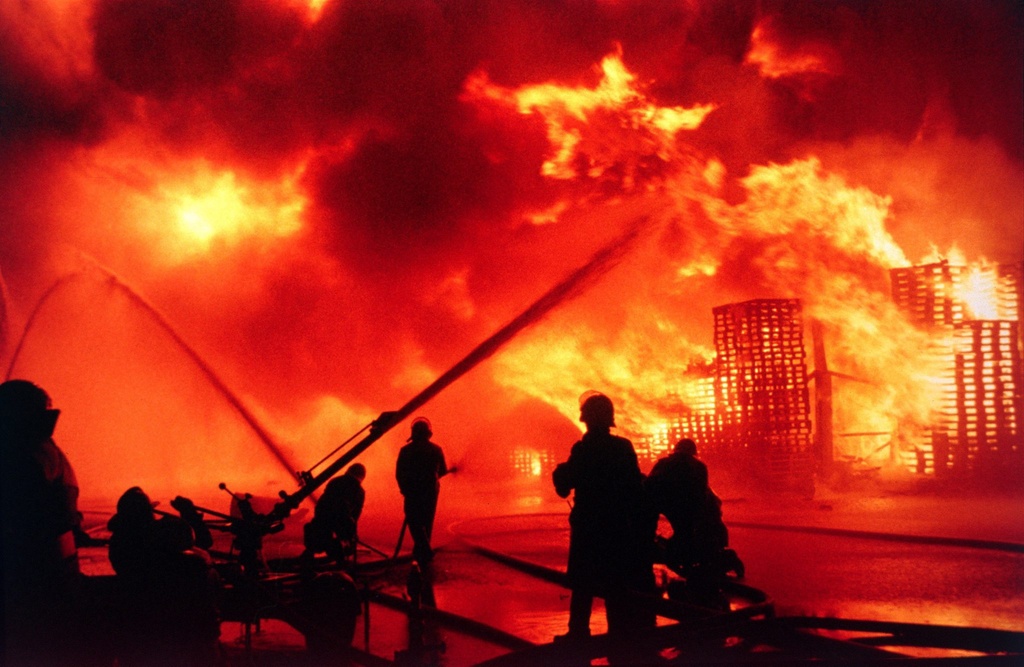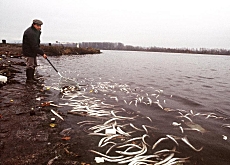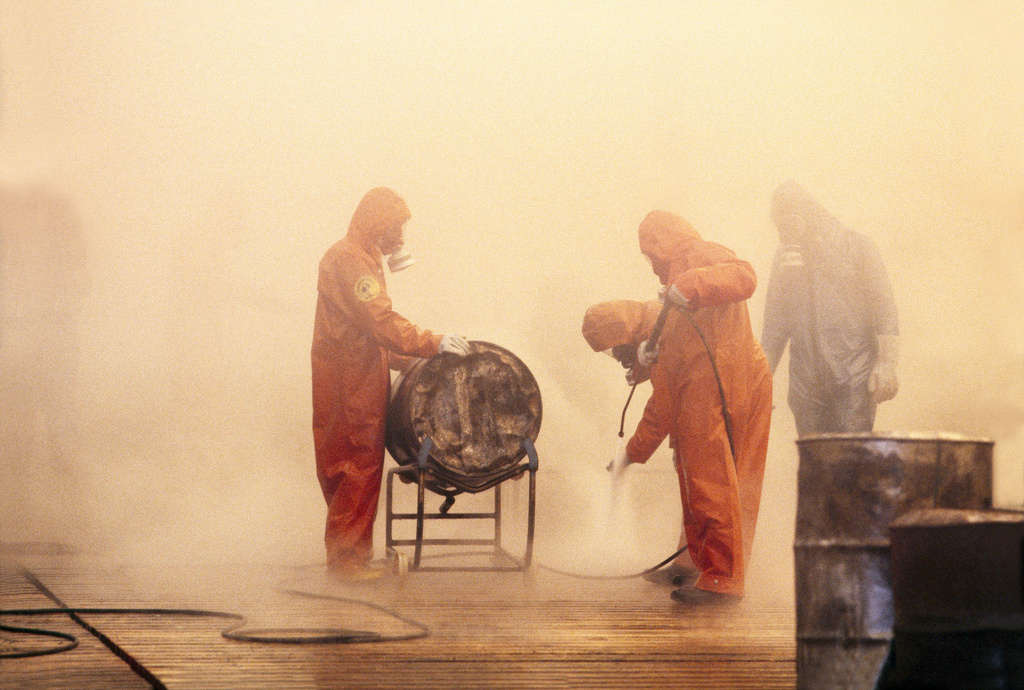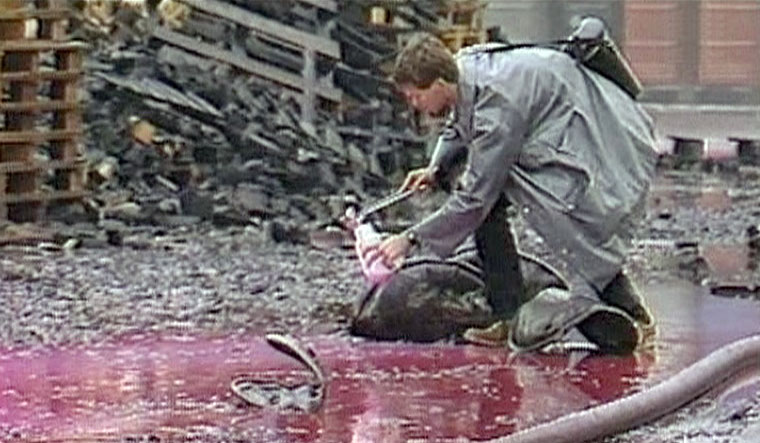Schweizerhalle site row refuses to die down

Twenty-five years after a fire caused a major chemical spill near Basel, questions are still being raised about how much pollution remains at the blaze site.
Basel Country environment officials say there is no need for action, a claim contested by a chemicals site expert.
In the early hours of November 1, 1986, fire broke out at a warehouse belonging to chemicals company Sandoz at the Schweizerhalle industrial area just outside Basel. Around 1,351 tonnes of pesticides and agrochemicals went up in flames.
The accident turned the River Rhine red, killed thousands of fish and sent acrid smoke over the city. It was one of Europe’s worst environmental disasters and made world news.
Angry locals demanded action. In the end, however, only two firefighters were charged over the Rhine pollution resulting from their actions fighting the blaze. None of the Sandoz management was held to account.
But the company, which later merged with Ciba-Geigy to become Novartis, did pay SFr43 million ($49 million) in compensation to Switzerland and the other affected Rhine nations of France, Germany and the Netherlands, and gave SFr10 million to a Rhine fund for ecological research.
A year later the resilient river was already showing signs of recovery. By 2006 it was declared once again “a living river” by the International Commission for the Protection of the Rhine.
Fire site
Sandoz also agreed to clear up the fire site. Afterwards it covered the area with a thick layer of concrete. The site now belongs to and is used by chemicals company Clariant.
However, 25 years on, the issue of just how polluted the area remains – and whether this poses any risks – refuses to go away.
On October 21, the local authorities at canton Basel Country released a statement saying that the “Sandoz fire” accident site was considered “a contaminated site that requires monitoring”. But it insisted that, under current law, no further clean-up was necessary.
Clariant is, however, to provide a new monitoring concept by the end of February next year.
“We ascertained that only one substance exists in the ground water, [the pesticide] Oxadixyl,” Basel Country environmental protection and energy department head Alberto Isenburg told swissinfo.ch.
“A team of experts has investigated the concentration limits and put them at four milligrams per litre.”
This was, by a factor of 500, below the limits set out in the Contaminated Sites Ordinance, he said, and had been approved by the Federal Environment Office.
The statement also pointed to “a few hundred kilogrammes” of Oxadixyl in the ground which is expected to degrade naturally but slowly over the next decades.
Criticism
For Basel chemical sites expert Martin Forter, author of a recent and much cited book on the environmental disaster, the Schweizerhalle decision is not acceptable.
The standards for pollutants set out in the original agreement between Sandoz and the authorities should have been reached by 1994 – 17 years ago, Forter said. Now the authorities have brushed aside the old limits, instead of pushing for action, he added.
“The local government has given out a fatal signal just before the 25th anniversary of the Schweizerhalle fire: it’s rewarding the industry for never keeping to its agreement with the authorities,” he told swissinfo.ch.
According to his research, there is still a pollution risk for drinking water as the next well is just 200 metres away.
“It’s time for the successors of Sandoz, primarily the pharmaceutical company Novartis, to clean up now and close the chapter,” he said.
Responsibilities
Isenburg said that his department was obliged as the controlling authority to assess the site according to the current legal situation.
“Should something change tomorrow, the next day or in the next years, then we are obliged to reassess the situation,” he said.
As for the industry, in a joint statement, Clariant, Novartis and Syngenta said that they welcomed the Schweizerhalle decision.
“The companies of the Basel chemical and pharmaceutical industry will continue to uphold their responsibilities with regard to comprehensive sustainability,” they said.
And in a further move, they added that they would “conduct an in-depth review of suitable measures aimed at releasing future generations from any responsibility for the accident site”.
The fire is thought to have been caused after a shrink gun used on pallets containing the dye Prussian Blue caused smouldering, which eventually ignited.
The fire broke out in the early hours of the morning. Sirens were sounded and people were told to stay indoors. By 5am the blaze was under control.
The river turned red after the water run-off from firefighting operations mixed with the chemicals and seeped into the river. Thousands of fish died and the eel were wiped out.
Anger was high among the local population. A week after the accident, 10,000 people took part in a demonstration.
Environmental laws were boosted and better monitoring both at local and international levels, also for the Rhine, was set up. Retention basins to gather water were made obligatory.
The Ordinance on Major Accidents came into force on April 1, 1991 to protect against the “adverse effects” of serious chemical or biological hazard accidents.
The industry also improved its safety and monitoring measures.

In compliance with the JTI standards
More: SWI swissinfo.ch certified by the Journalism Trust Initiative






You can find an overview of ongoing debates with our journalists here. Please join us!
If you want to start a conversation about a topic raised in this article or want to report factual errors, email us at english@swissinfo.ch.